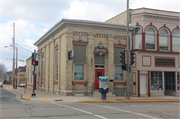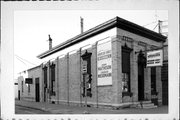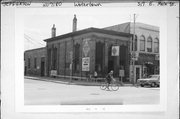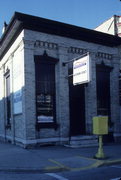Property Record
317 E MAIN ST
Architecture and History Inventory
| Historic Name: | Assistant's Bank; Schulte Agric. Implements |
|---|---|
| Other Name: | Wesemann Insurance Agency |
| Contributing: | Yes |
| Reference Number: | 7180 |
| Location (Address): | 317 E MAIN ST |
|---|---|
| County: | Jefferson |
| City: | Watertown |
| Township/Village: | |
| Unincorporated Community: | |
| Town: | |
| Range: | |
| Direction: | |
| Section: | |
| Quarter Section: | |
| Quarter/Quarter Section: |
| Year Built: | 1884 |
|---|---|
| Additions: | |
| Survey Date: | 19862020 |
| Historic Use: | bank/financial institution |
| Architectural Style: | Neoclassical/Beaux Arts |
| Structural System: | |
| Wall Material: | Cream Brick |
| Architect: | |
| Other Buildings On Site: | |
| Demolished?: | No |
| Demolished Date: |
| National/State Register Listing Name: | Main Street Commercial Historic District |
|---|---|
| National Register Listing Date: | 6/2/1989 |
| National Register Multiple Property Name: |
| Additional Information: | This building was constructed in 1884 as the Assitant's Bank, a short-lived financisl institution in Watertown. After the bank closed, it housed the William Schulte agricultural implements store, then between c. 1907 and at least 1930, it was the location of the Watertown Grain Company, a commission house. In 1900, this was also the location of the German newspaper, the Weltburger. This building is significant for local history under National Register criterion A because it housed the Watertown Grain Company and the offices of the Weltburger newspaper. The Watertown Weltburger was the most significant German-language newspaper in the community. It began in the 1850s and for a number of years was operated and edited by David Blumenfeld. The Weltburger and a number of locations in Watertown's commercial district. For a few years around 1900, it was located here. The Watertown Grain Company was one of the largest and most successful produce commission merchants in the community. In the twentieth century, the Watertown Grain Company had another distinction. It was one of the largest firms to market the famous Watertown Stuffed Goose. Goose stuffing was a reportedly German tradition of fattening geese for several weeks in order to produce larger than normal livers for pate de fois gras. Watertown had a reputation for producing this delicacy and during the early twentieth century, probably was the only area to supply these geese. Most geese were stuffed on farms outside of the city so the few resources remaining of this small industry are significant. Built in 1884 for the short lived Assistant's Bank, this one-story cream brick Neo-classical influenced building features a projecting wooden cornice and plain frieze supported by capped brick end piers and capped brick pilasters along the facade and the east elevation. Projecting wooden cornices ornamented by classical urns as well as classical bead moldings and console ends top the long rectangular windows. Also featuring projecting wooden sills with console supports. A broken pediment with similar ornament projects above the entrance in the central recessed bay of the facade. Modillions decorate the top of the three recessed bays situated between the applied pilasters on the facade. A stone water table runs along the base of the building. A one-story cream brick rear section built for rental space and originally used as an agricultural implement store is located at the rear of the former bank building. The former Assistant's Bank building is significant under criterion C as an example of the 19th century Neo-classcal influence in the commercial district. The only Neo-classical styled building remaining from the 19th century in the district, this building continues to exhibit an entablature visually supported by applied pilasters suggesting of a classical temple structure. Although the window sashes have been replaced, the wooden window and door cornices remain on the building. Also the exterior brick surface apparently has been sandblasted. Built in 1884 in the Neo-classic style frequently used by public institutions to symbolize stability and status in the 19th and early 20th century, the Assistant's Bank only survived a few years after which time the building began to serve a variety of uses. Other good examples of the Neo-classical style include the Public Library at 100 So. Water (65-23), the Bank of Watertown at 14 E. Main (72-24), the Archie Brothers Monument Works at 218 So. 1st and the King House at 802 So. 8th (38-11). |
|---|---|
| Bibliographic References: | (A) Tax Records, City of Watertown, 1860-1910, Area Research Center, Library, University of Wisconsin-Whitewater. (B) Sanborn Insurance Map, City of Watertown, 1884. (C) Watertown City Directories, 1866-1930, Watertown Public Library. |
| Wisconsin Architecture and History Inventory, State Historic Preservation Office, Wisconsin Historical Society, Madison, Wisconsin |





